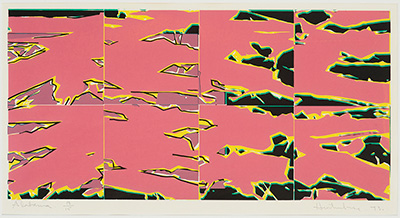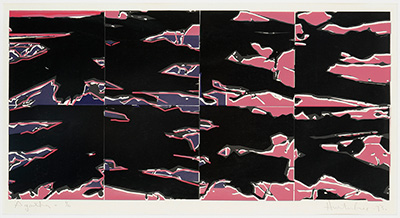(1939-2014)
Located in hallway CL 101 (Classroom Building, 1st floor)

Jacques Hurtubise, Alabama (purple, yellow, green, black) (3/15), 1973. © Estate of Jacques Hurtubise / SODRAC (2018). Photograph by the University of Regina.

Jacques Hurtubise, Agatha (6/30), 1973. © Estate of Jacques Hurtubise / SODRAC (2018). Photograph by the University of Regina.
Alabama (purple, yellow, green, black) (3/15), 1973
Silkscreen on paper
15” x 29”
University of Regina President’s Art Collection; pc.1974.13
Agatha (6/30), 1973
Silkscreen on paper
15” x 29”
University of Regina President’s Art Collection; pc.1974.11
By the time Montreal-born Jacques Hurtubise produced Alice, Agatha and Alabama in 1973, he had become an internationally established painter, participating in prestigious exhibitions and biennials worldwide. His foremost years as an artist were spent studying in Montreal and after winning a scholarship – New York. In 1972, he had enjoyed success at his first public gallery solo exhibition, shown at both the Musée du Quebéc and the Montreal Museum of Contemporary Art. He was to exhibit regularly and on an international level during the decades to come.
Much of his work consisted of large canvasses, coated with dripped and splashed Expressionist paint techniques, but also more graphic explorations incorporating Hard Edge abstraction. His silkscreen prints, as seen here, parallel that work. Exhibitions dedicated to these paper works were held at Marlborough Godard Gallery, including Agatha, which appeared there in 1973.
“I am very instinctive. Everything is in my head and in my head it is very abstract. It doesn’t come out in explanation. It doesn’t come out in words. It comes out in paint. It’s visual. Instinctive and visual”, Hurtubise noted in 1981. Whilst he identified as an instinctive artist, his work was nonetheless methodical, giving the impression of dynamic, random or gestural strokes. Other work similarly used motifs such as splashes and blots. The controlled “brushstrokes” have often been compared to those of the Pop artist Roy Lichtenstein in that they both share designs that give the effect of the kind of gesture described above, that of the action painter. The painstaking and detail-oriented printmaking process is also testament to this. Agatha, Alabama and Alice display gestural – and even doodle-like – effects reined-in by grid-like design. In this way Hurtubise appears to consider printmaking’s techniques as no less significant than painting’s, in terms of the traditional modernist hierarchy which places painting at the top. The production of multiples was also a way to make high art affordable for a much wider audience, which satisfied the democratic ideals of the day.
Hurtubise’s reputation as a “remarkable colourist” and use of fluorescent hues is also evidenced in these prints, with their greedy, saturated colour and contrast. It follows that his electrifying painting developed into neon painting-esque sculptures for a period in the late 1960’s. The colour pink appeared frequently, from salmon, pastel to pepto-bismol and magenta, throughout his career. Above everything, Jacques Hurtubise’s work is about colour.


